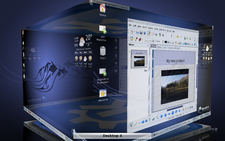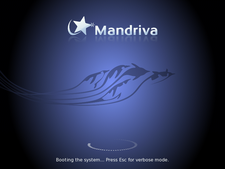Mandriva 2010.0: Faster and More Stable
The new Mandriva 2010.0 has been ready for download since yesterday. After a month's delay, the French distributor has released the current version, code-named Adelie, for free. Some important changes were made.
Most of the changes to the Mandriva release are on the project wiki. Immediately noticeable are the visuals: it now uses Plymouth software for bootsplash. The wallpaper designs were created as the result of a competition. Mandriva 2010.0 boots markedly faster and integrates a complete Moblin environment so that it can run well on netbooks. It also includes Sugar, the desktop created for the One Laptop per Child (OLPC) program. Users surf using Firefox 3.5 and create text and calculations with OpenOffice.org 3.1.1. Mandriva is based on X.org 7.4 and the Intel graphics chips should perform better thanks to DRI2 and UXA architecture.
The desktop environments are KDE 4.3 and GNOME 2.28. Data can migrate from KDE 3 to KDE 4 and integration with the Nepomuk semantic desktop was taken a step further. Activities can be tied to virtual desktops. KDE 4.3 includes Amarok 2.2, Digikam 1.0 beta5 and Skrooge, which replaces (and can import data from) the unstable Kmymoney2. Phonon integration with PulseAudio is also now tighter.
The GNOME environment now allows webcam sessions and live streaming. Tomboy notes are also synchronizable with the Snowy web service. The Pitivi video editor was updated to 0.13.0, and Empathy replaces Pidgin as the default and supports audio-visual chats.
The Elisa multimedia center was renamed Moovida and "includes a brand new graphical user interface." Other changes include the Phoronix test suite with which users can benchmark their Linux system. Guest systems run best on the Mandriva-supported Virtual Box 3.0.8, which also supports OpenGL. The included Wine 1.1.32 Windows runtime environment has performance improvements and better DirectX 10 support. Developers also improved Bluetooth device support and the GNOME power manager now services laptops with multiple batteries.
Mandriva downloads are installable as 32-bit and 64-bit versions from DVD. A dual-arch CD contains a minimal system installable over the web, while the One edition is a LiveCD with KDE or GNOME as the desktop.
Comments
comments powered by DisqusSubscribe to our Linux Newsletters
Find Linux and Open Source Jobs
Subscribe to our ADMIN Newsletters
Support Our Work
Linux Magazine content is made possible with support from readers like you. Please consider contributing when you’ve found an article to be beneficial.

News
-
Debian Unleashes Debian Libre Live
Debian Libre Live keeps your machine free of proprietary software.
-
Valve Announces Pending Release of Steam Machine
Shout it to the heavens: Steam Machine, powered by Linux, is set to arrive in 2026.
-
Happy Birthday, ADMIN Magazine!
ADMIN is celebrating its 15th anniversary with issue #90.
-
Another Linux Malware Discovered
Russian hackers use Hyper-V to hide malware within Linux virtual machines.
-
TUXEDO Computers Announces a New InfinityBook
TUXEDO Computers is at it again with a new InfinityBook that will meet your professional and gaming needs.
-
SUSE Dives into the Agentic AI Pool
SUSE becomes the first open source company to adopt agentic AI with SUSE Enterprise Linux 16.
-
Linux Now Runs Most Windows Games
The latest data shows that nearly 90 percent of Windows games can be played on Linux.
-
Fedora 43 Has Finally Landed
The Fedora Linux developers have announced their latest release, Fedora 43.
-
KDE Unleashes Plasma 6.5
The Plasma 6.5 desktop environment is now available with new features, improvements, and the usual bug fixes.
-
Xubuntu Site Possibly Hacked
It appears that the Xubuntu site was hacked and briefly served up a malicious ZIP file from its download page.



Lovin' 2010.0